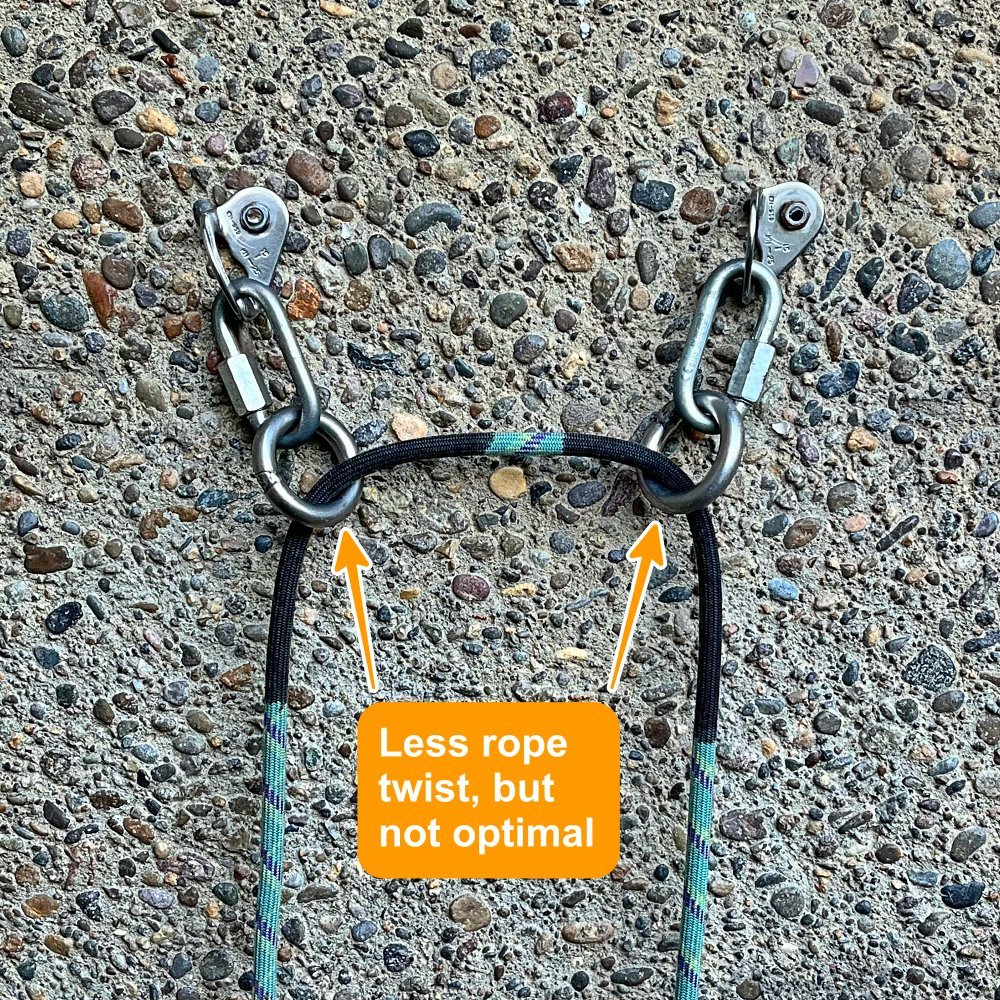Anchor-induced rope twisting
Some configurations of anchor hardware can give you a smooth easy rope pull with no twists. Others can add some snarls to your rope. Here are a few examples of each.
Side note: if the rock below the anchor is slab / lower angle, that often leads to more twists. If it’s hanging pretty much freely or vertical, it’s usually less twisting.
Do you need to rappel, lower off, or redirect a lower from an anchor rigged like the top photo? Be prepared for some possible rope twisting.
When you run a weighted rope through anchor point(s) with the bottom link(s( lying flat against the rock like this, the rope drags at these two spots and starts spiraling, which can put some serious pigtails in your rope.
The general concept: the more friction and direction changes, the more twisting will happen.
(It's unlikely you will ever see this, because any halfway competent route setter will add another link so it looks like the second photo below, but it's possible; I've seen it a few times.)
If you have two extra quick links with you, or maybe want to donate a couple of carabiners, you can add those to the anchor to improve it as shown below. You might want to tape the gates of the carabiner closed, to discourage people from stealing them.
If you don't have any hardware to enhance the anchor, there's probably not much you can do about it. If rappelling, try to separate the rope strands when you pull them, so one doesn’t twist around the other which might make pulling your rope difficult to impossible. If it's your local crag, be a good citizen, climb up there another day with some hardware and re-rig it as shown below.
One improvement: add a second set of either welded steel rings (preferred, as they rotate and last longer) or good quality quick links. Note that these are now perpendicular to the rock. This results in an easier rope pull with less twisting. But, depending on a few other variables, your rope might still get a bit pigtailed.
Of course, if adding rings you’ll need to open the sleeve of the existing quick link, so be sure and bring some pliers.
It helps if the bolts are aligned horizontally. If one bolt is a bit higher than the other in this setup, you still might get a little rope twist, but not nearly as badly as you might without the second link/ring.
The closer together the rings are, generally the less rope twist you will have.
Lowering someone tends to create more twists, because the rope has a higher load. If come across anchors like the image below, you might be better off rappelling rather than lowering.
Anytime you're putting a quick link on an anchor, especially at a popular climbing area, it's best practice to use at least 8 mm (and perhaps even 10 mm) and ideally proper CE climbing rated quick links rather than random ones from the hardware store. CAMP is one of several manufacturers to offer strong, inexpensive, CE rated quick links, read an article about that here.
One more quick link note: it's best practice to place quicklinks so the threaded sleeve closes in a downward direction. That way, if the sleeve ever loosens, gravity helps hold it closed. As the saying goes, ”Screw down so you don't screw up.”
If you’re setting quick links in a more permanent position, give them a good crank with some pliers or a wrench and maybe some Loctite on the threads. If you do that, it doesn't matter which way the threaded sleeve is facing.
A great way to rig a rappel anchor for minimal rope twisting is to have two points that come together at the same level.
Even better, a single point of connection. Like this welded ring rated for something ridiculous like more than 80 kN. Yes, it’s not redundant, but you can trust this absolutely.
Tip: If your rope does get twisted, when you get to the bottom or maybe the next lower anchor, try pulling the entire rope through a tube style belay device clipped above you. This can be a fast way to remove the pigtails. Read how to do that at this article.





